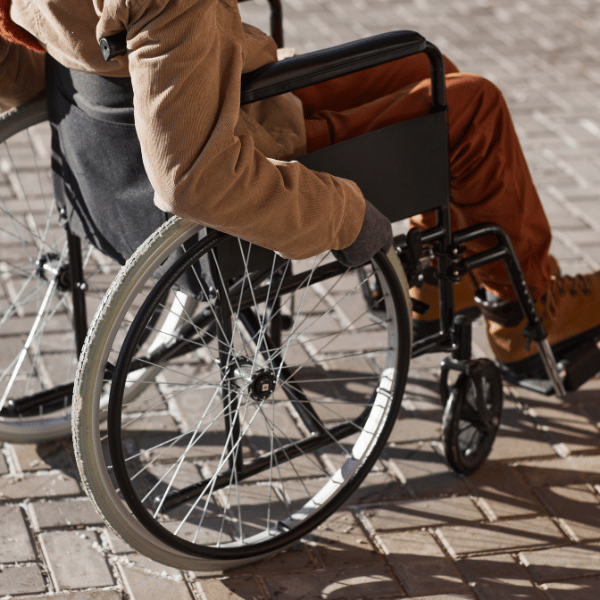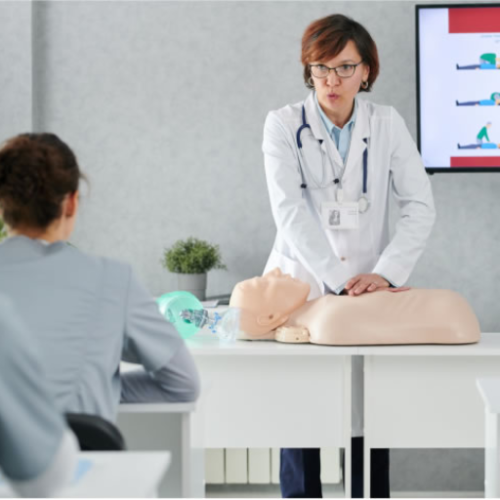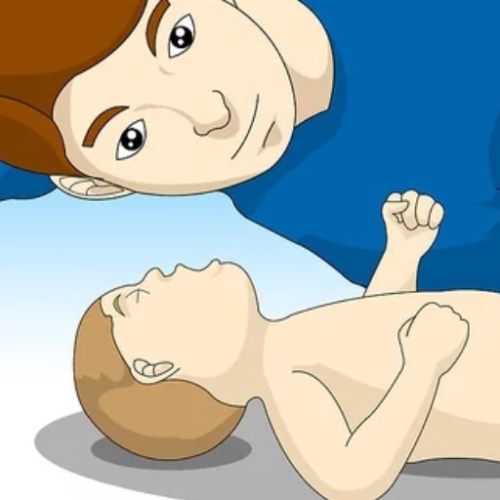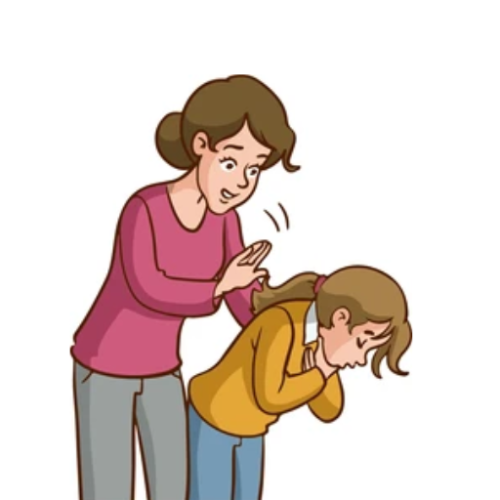
What to Do If Someone Is Choking?
If someone is choking, act quickly and calmly. First, confirm if the person is choking by observing their behavior or verbal communication. If they are coughing forcefully, encourage them to keep coughing as it may dislodge the obstruction. However, immediate intervention is necessary if they cannot cough, speak, or breathe. For wheelchair users, you can adapt the Heimlich maneuver by positioning yourself behind them, leaning them slightly forward, and applying firm upward thrusts just above their abdomen to expel the blockage.
How to Identify the Universal Sign of Choking?
The universal sign of choking involves the choking individual clutching their throat with one or both hands. Other cues to look for include the inability to speak, coughing weakly (or not at all), lips or skin turning blue due to lack of oxygen, or signs of distress and panic. Recognizing these indicators is critical for providing immediate assistance.
What Are the Risks of Choking for Wheelchair Users?
Wheelchair users may face unique risks of choking due to factors such as reduced mobility, medical conditions affecting swallowing (like dysphagia), or reliance on caregivers during meals. Conditions like spinal cord injuries or neurological impairments can also increase their vulnerability. Quick action and familiarity with adaptive first-aid techniques are crucial.
How to Ask Someone if They're Choking?
To confirm if someone is choking, approach them calmly and ask, "Are you choking?" If the individual cannot respond verbally, this is a strong indication of airway blockage. Stay composed and proceed with the Heimlich maneuver, or notify someone to call emergency services if you need additional help. Always act swiftly but cautiously to ensure their safety.
How to Perform the Heimlich Maneuver on a Wheelchair User?
Assisting a choking wheelchair user requires careful adjustments to ensure their safety and the effectiveness of the Heimlich maneuver. Follow these steps to provide the necessary aid:
What Are the Steps to Perform the Heimlich Maneuver?
- Assess the Situation: Confirm the individual is choking by asking, "Are you choking?" Look for universal choking signs, such as the inability to speak, breathe, or cough.
- Position Yourself Properly: Approach the individual from behind in the wheelchair and ensure you can apply appropriate pressure without causing harm.
- Secure the Chair: If the wheelchair has brakes, ensure they are engaged to prevent movement during the maneuver.
- Locate the Correct Spot: Find the area just above the belly button and below the rib cage, known as the diaphragm area.
- Apply Abdominal Thrusts: Place your fist on the diaphragm spot, cover it with your other hand, and deliver quick, inward and upward thrusts. Repeat until the airway is clear or emergency services arrive.

How to Stand Behind the Choking Person in a Wheelchair?
Standing effectively behind a wheelchair user involves attention to positioning for optimal leverage. Stand slightly to the side and behind the chair, leaning forward to reach the individual’s upper abdomen. Ensure your motions are steady, and secure the wheelchair's position to avoid pushing it backward.
What Are the Key Techniques for Abdominal Thrusts?
The core technique involves applying controlled but forceful abdominal thrusts to expel the obstructing object from the airway. Key points to remember include:
- Focus on the Diaphragm: Ensure the pressure is applied in the correct abdominal location to maximize effectiveness.
- Use Proper Force: Use enough pressure to create a forceful airflow but avoid excessive force that could cause injury.
- Maintain Rhythm: Perform continuous thrusts without unnecessary pauses until airway is clear.
By mastering these techniques, you can provide potentially life-saving aid to a choking individual in a wheelchair, ensuring their safety with minimal risk of harm. Always remain calm and act swiftly to improve the outcome.
Alternatives to the Heimlich Maneuver
While abdominal thrusts, commonly known as the Heimlich maneuver, are a widely accepted technique for addressing choking, alternative methods can be equally effective depending on the situation and the individual involved.
When to Use Back Blows Instead of Abdominal Thrusts
Back blows are a viable alternative to abdominal thrusts, particularly in cases where the latter might not be suitable or effective. For instance, back blows are recommended for infants under one year of age, as performing abdominal thrusts on a small body can cause significant injury. Additionally, in cases involving individuals for whom abdominal thrusts are not feasible due to medical conditions, excessive body weight, or pregnancy, back blows may be used as the initial approach to dislodging the obstruction.
To perform back blows correctly:
- Position the individual leaning forward slightly so gravity can aid in expelling the object.
- Use the heel of your hand to deliver firm blows between the shoulder blades.
- Perform up to five back blows, checking after each blow to see if the obstruction has been cleared.
How to Combine Back Blows and Abdominal Thrusts?
Combining back blows with abdominal thrusts can increase the likelihood of dislodging the object for adults or children over one year old. This combination method is especially effective when initial attempts with either technique fail to resolve the issue. The recommended approach is:
- Perform five back blows as described above.
- If the airway remains obstructed, transition to five abdominal thrusts.
- Alternate between back blows and abdominal thrusts until the obstruction is cleared or professional help arrives.
Switching between these techniques creates varied mechanical forces that can help dislodge the object more effectively.
What to Do If the Choking Doesn't Dislodge?
If the choking persists despite your interventions:
- Call emergency services immediately if you haven’t already done so.
- Continue administering cycles of back blows and abdominal thrusts while awaiting professional help.
- If the individual becomes unresponsive, begin CPR immediately. For adults and children, this involves chest compressions and rescue breaths. For infants, ensure the method of CPR is adjusted to their size and needs.
- If available, use an Automated External Defibrillator (AED), following the device's instructions while maintaining focus on CPR.
Every second counts as a choking emergency. Acting decisively and effectively while knowing when to seek advanced medical assistance can make all the difference in saving a person's life.
First Aid Advice for a Choking Emergency
When someone is choking, it is critical to act quickly and follow these steps:
- Assess the Situation
Check whether the individual can breathe, speak, or cough. Encourage them to continue if they can cough forcefully, as coughing may dislodge the obstruction.
- Deliver Back Blows
If the person cannot clear the blockage by coughing, stand behind them and use the heel of your hand to deliver up to five sharp back blows between their shoulder blades.
- Perform Abdominal Thrusts (Heimlich Maneuver)
For adults and children over one-year-old, wrap your arms around their waist, make a fist, and position it just above the navel. Grasp your fist with your other hand and quickly thrust inward and upward. Repeat up to five times if necessary. Apply chest thrusts instead for pregnant individuals or those you cannot lift.
- Alternate Back Blows and Thrusts
If the object remains lodged, alternate between back blows and abdominal thrusts until the airway is cleared or the person becomes unresponsive.
- Call Emergency Services
If the choking persists or the individual becomes unconscious, contact emergency services immediately for advanced medical assistance.
How to Prepare for Potential Choking Situations?
Performing CPR if the Victim Becomes Unresponsive
If the choking victim becomes unresponsive:
- Check for Breathing and Pulse
Tilt the victim's head back to open the airway and check for normal breathing or a pulse. If absent or irregular, start CPR immediately.
- Administer Chest Compressions
Place your hands, one over the other, in the center of the chest. Push hard and fast, delivering 100–120 compressions per minute. Allow the chest to recoil between compressions fully.
- Attempt Rescue Breaths
After 30 compressions, tilt the head back, seal your mouth over theirs, and deliver two rescue breaths. Ensure the chest rises with each breath. If the chest does not rise, the airway may still be blocked—look into the mouth and remove any visible obstruction if possible.
- Continue CPR and Use an AED
Repeat the cycle of 30 compressions and two breaths until the object is dislodged, professional help arrives, or the victim shows signs of recovery. When an Automated External Defibrillator (AED) becomes available, use it and follow the device's prompts.
What Preventive Measures Can Reduce the Risk of Choking?
Signs That Immediate Help Is Needed
Immediate medical assistance should be sought in the following situations:
- The person cannot breathe, speak, or make any sound.
- Persistent choking occurs despite administering back blows and abdominal thrusts.
- The individual becomes unconscious or unresponsive.
- There is visible cyanosis (bluish discoloration) of the lips, face, or extremities.
- If a choking infant or child is involved and initial attempts do not succeed.
Following these steps and recognizing critical signs can significantly improve the chances of saving a life during a choking emergency.
How to Educate Others About Choking First Aid?
Educating others about choking first aid requires clear, actionable information presented in an organized and practical manner. Explain the importance of being prepared and understanding the basics of choking emergencies. Highlight that choking can happen anytime and often requires immediate intervention to prevent severe consequences.
- Explain the Signs of Choking
Teach individuals to recognize key signs of choking, such as the inability to speak, breathe, or cough, and physical indications, such as clutching the throat, cyanosis, or sudden silence.
- Demonstrate First Aid Techniques
Provide a step-by-step overview of the Heimlich maneuver (abdominal thrusts) and back blows for adults, children, and infants. Include techniques for self-rescue in case the choking victim is alone. Use practical demonstrations or videos for clarity.
- Stress the Importance of Remaining Calm
Educate individuals on staying composed during a choking emergency. This will ensure they can effectively perform first-aid techniques and reassure the victim.
- Encourage Hands-On Training
Hands-on training sessions, such as CPR and first aid courses, allow participants to practice techniques under professional supervision, improving their confidence and competence.
- Distribute Educational Materials
To reinforce learning, use pamphlets, infographics, and digital content. Visual aids often help learners retain critical information about choking first aid.
- Promote the Presence of Emergency Numbers
Remind individuals always to have emergency numbers ready and to contact medical professionals immediately after choking incidents, even if the object has been expelled.
- Engage in Community Awareness Programs
Organize workshops, seminars, or online webinars to educate groups or communities. Public events ensure that a broader audience learns life-saving skills.
By focusing on these methods, you can help others gain the knowledge and confidence to act effectively in choking situations, increasing the likelihood of positive outcomes while fostering a safer environment.
Frequently Asked Questions
Q: What should I do if I think someone is choking?
A: If you think someone is choking, ask them if they are okay. If they cannot respond or cough, proceed with first aid techniques, including five back blows followed by five abdominal thrusts.
Q: How do I perform the Heimlich maneuver on a wheelchair user?
A: To perform the Heimlich maneuver on a wheelchair user, wrap your arms around their waist, making sure to position your hands above their navel. Then, perform abdominal thrusts inwards and upwards until the obstruction is cleared or help arrives.
Q: What are the signs of airway obstruction?
A: Signs of airway obstruction include inability to speak, difficulty breathing, coughing, or clutching the throat. If the choking victim exhibits these signs, immediate action is required.
Q: Can I perform back blows on a choking victim in a wheelchair?
A: Yes, you can perform five back blows on a choking victim in a wheelchair. Lean the person slightly forward and deliver firm blows between the shoulder blades using the heel of your hand.
Q: What should I do if the choking victim becomes unconscious?
A: If the choking victim becomes unconscious, lower them to the ground and call for emergency help. If trained, begin basic first aid, including chest compressions and rescue breaths until professional help arrives.
Q: How many thrusts should I perform if someone is choking?
A: You should perform five abdominal thrusts followed by five back blows. Continue this cycle until the object is dislodged or help arrives.
Q: Is it necessary to perform resuscitation if the person recovers from choking?
A: Resuscitation is unnecessary if the person recovers and starts breathing normally. However, if they remain unresponsive or show signs of distress, begin CPR or call for emergency assistance.
Q: What techniques are used in resuscitation for choking victims?
A: Resuscitation techniques for choking victims may include abdominal thrusts, back blows, and, if necessary, chest compressions. These techniques aim to clear the airway obstruction and restore normal breathing.
Q: How do I know if someone needs abdominal thrusts?
A: If the choking victim cannot cough, speak, or breathe, they likely need abdominal thrusts. Observing signs of severe distress or a lack of airflow indicates that further action is required.
Q: What should I do if I am choking and alone?
A: If you are choking and alone, you can perform abdominal thrusts on yourself by placing a fist above your navel and thrusting inwards and upwards against a solid surface, such as a chair or countertop, until the blockage is cleared.
References
-
First Aid Advice For Assisting A Wheelchair-Bound Person: This source offers detailed guidance on how to assist a choking person in a wheelchair, including specific techniques.
-
How to deal with a choking wheelchair user: A training video from Aid Training that demonstrates how to handle choking incidents involving wheelchair users.
-
For wheelchair users, what happens when the Heimlich ...: This article discusses adaptations of the Heimlich maneuver for wheelchair users, providing practical insights and techniques.









 Login with Google
Login with Google Login with Facebook
Login with Facebook